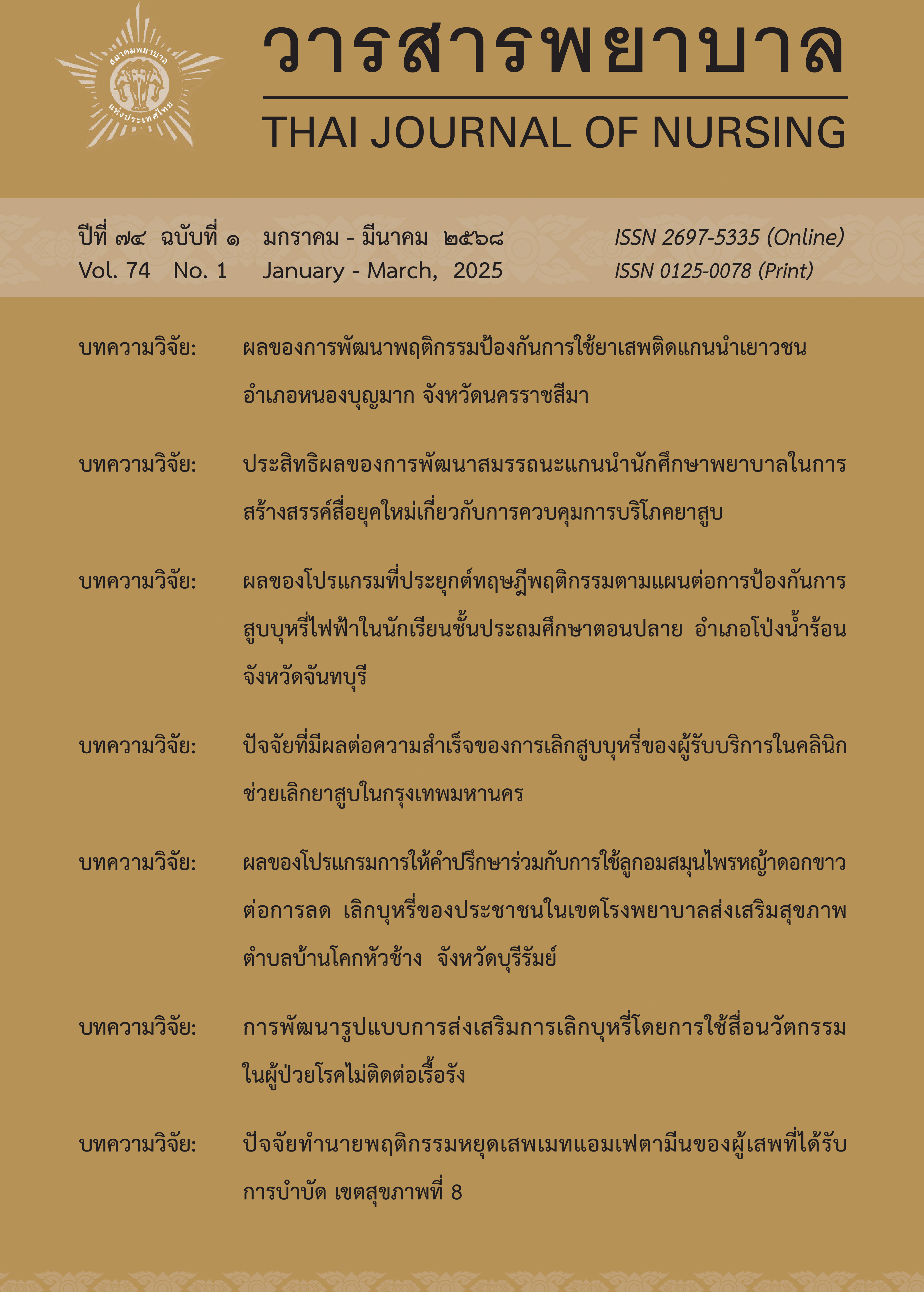ผลของโปรแกรมการให้คำปรึกษาร่วมกับการใช้ลูกอมสมุนไพรหญ้าดอกขาวต่อการลด เลิกบุหรี่ของประชาชนในเขตโรงพยาบาลส่งเสริมสุขภาพตำบลบ้านโคกหัวช้าง จังหวัดบุรีรัมย์
Main Article Content
บทคัดย่อ
การวิจัยกึ่งทดลองนี้ มีวัตถุ ประสงค์เพื่อเปรียบเทียบความรอบรู้ด้านสุขภาพเรื่องบุหรี่ พฤติกรรมลดเลิกบุหรี่ จำนวนมวนบุหรี่สูบต่อวัน การติดสารนิโคติน ก่อนและหลังเข้าร่วมโปรแกรมการให้คำปรึกษาร่วมกับการใช้ลูกอมสมุนไพรหญ้าดอกขาวของประชาชนในเขตโรงพยาบาลส่งเสริมสุขภาพตำบลบ้านโคกหัวช้าง จังหวัดบุรีรัมย์ กลุ่มตัวอย่าง จำนวน 30 คนเลือกแบบเจาะจง เครื่องมือวิจัยได้แก่ โปรแกรมการให้คำปรึกษาร่วมกับการใช้ลูกอมสมุนไพรหญ้าดอกขาว และแบบสอบถามความรอบรู้ด้านสุขภาพเรื่องบุหรี่ พฤติกรรมลด เลิกบุหรี่ จำนวนมวนบุหรี่สูบต่อวัน และระดับการติดสารนิโค ติน วิเคราะห์ข้อมูลด้วยสถิติเชิงพรรณนา และการทดสอบที ผลการศึกษาพบว่า หลังเข้าร่วมโปรแกรมการให้คำปรึกษาร่วมกับการใช้ลูกอมสมุนไพรหญ้าดอกขาว ผู้สูบบุหรี่มีค่าเฉลี่ยของความรอบรู้ด้านสุขภาพเรื่องบุหรี่ และพฤติกรรมลด เลิกบุหรี่ มากกว่า ก่อนเข้าร่วมโปรแกรมการให้คำปรึกษาร่วมกับการใช้ลูกอมสมุนไพรหญ้าดอกขาว และมีค่าเฉลี่ยของจำนวนมวนบุหรี่ที่สูบต่อวัน และการติดสารนิโคติน น้อยกว่า ก่อนเข้าร่วมโปรแกรมการให้คำปรึกษาร่วมกับการใช้ลูกอมสมุนไพรหญ้าดอกขาวอย่างมีนัยสำคัญทางสถิติที่ระดับ .05
Article Details

อนุญาตภายใต้เงื่อนไข Creative Commons Attribution-NonCommercial-NoDerivatives 4.0 International License.
เอกสารอ้างอิง
กัญญภัค สุวรรณศรี. (2566). ผลโปรแกรมสุขศึกษา เพื่อปรับเปลี่ยนพฤติกรรมในการเลิกสูบบุหรี่ของผู้ที่สูบบุหรี่ เขตโรงพยาบาลส่งเสริมสุขภาพตำบลหนองบัว อำเภอเมือง จังหวัดอุดรธานี. วารสารสุขภาพและสิ่งแวดล้อมศึกษา, 8 (2), 89-100.
กิจปพน ศรีธานี, ปภาวี รัตนธรรม, สุรัตนา เหล่าไชย, และราณี ภูจอมแก้ว. (2565). ประสิทธิผลของผลิตภัณฑ์สมุนไพรหญ้าดอกขาวในการลดพฤติกรรมการสูบบุหรี่ของประชาชนชุมชนบ้านคําปะโอ ตําบลกุดโดน อําเภอห้วยเม็ก จังหวัดกาฬสินธุ์. วารสารวิทยาศาสตร์และเทคโนโลยีมหาวิทยาลัยราชภัฏมหาสารคาม, 5 (1), 29-48.
ชมนาด พจนามาตร์, มัลลิกา มาตระกูล, นาตญา พแดนนอก, และอรนลิน สิงขรณ์. (2563). การให้คำปรึกษาเพื่อการเลิกบุหรี่ด้วยการควบคุมตนเอง. วารสารพยาบาล, 69(1), 54 - 61.
ดาราวรรณ ต๊ะปินตา.(2558). การให้การปรึกษาโดยการปรับความคิดและพฤติกรรม. พยาบาลสาร, 42 (ฉบับพิเศษ), 205-212.
ดลณชา อิสริยภานันท์, นวลใย พิศชาติ, อุบล ชุ่มจินดา, วิเนตรา แน่นหนา, และนภวรรณ แก้ววังอ้อ. (2566). ผลของลูกอมสมุนไพรหญ้าดอกขาวในการลดพฤติกรรมการสูบบุหรี่ของประชาชน ชุมชนบางเตย อำเภอสามโคก จังหวัดปทุมธานี. วารสารการแพทย์โรงพยาบาลอุดรธานี, 31(2), 142-152.
ธนวัฒน์ งามศรี, อุดม มาสแสง, ธิดารัตน์ ชิตวัชระ, และกรองทอง เจริญ.(2564). การศึกษาเปรียบเทียบระดับการติดสารนิโคตินระหว่างการใช้สมุนไพรหญ้าดอกขาวและการนวดบำบัด.วารสารสหวิชาการเพื่อสุขภาพ, 3(1), 29-40.
ธนะวัฒน์ รวมสุก, อารยา ทิพย์วงศ์, พรพรรณ วรสีหะ, และสุรินธร กลัมพากร. (2021). ผลของโปรแกรม ส่งเสริมความรอบรู้ทางสุขภาพและสมรรถนะแห่งตนต่อการช่วยเลิกบุหรี่ของอาสาสมัครสาธารณสุขประจำหมู่บ้าน จังหวัดสมุทรสงคราม. Thai Journal of Public Health, 51(3), 214-222.
ลักขณา สิริรัตนพลกุล. (2564). ปัจจัยที่มีความสัมพันธ์กับพฤติกรรมการเลิกบุหรี่ของผู้ป่วยที่มารับริการแผนก ผู้ป่วยนอก โรงพยาบาลเลิดสิน. รายงานวิจัย โรงพยาบาลเลิดสิน.
วีระศักดิ์ ปัญญาพรวิทยา. (2563). การคำนวณขนาดตัวอย่างโดยใช้โปรแกรม G*power. คณะสัตวแพทย ศาสตร์, มหาวิทยาลัยเชียงใหม่.
วนิดา พงษ์ศักดิ์ชาต, (2563). การคำนวณหาขนาดตัวอย่างเพื่องานวิจัย. คณะวิทยาศาสตร์ มหาวิทยาลัยบูรพา.
ศูนย์วิจัยและจัดการความรู้เพื่อการควบคุมยาสูบ. (2561, 18 พฤศจิกายน). ประสิทธิภาพ “ หญ้าดอกขาว ” เพื่อช่วยเลิกบุหรี่. ข่าวประชาสัมพันธ์, หน้าแรก. https://www.trc.or.th/ th/ศูนย์ข้อมูล/สื่อเผยแพร่/แผ่นพับชุดความรู้/196-ประสิทธิภาพ-“หญ้าดอกขาว”-เพื่อช่วยเลิกบุหรี่.html
สำนักงานกองทุนสนับสนุนการสร้างเสริมสุขภาพ. (2560, 17 ตุลาคม). บุหรี่มีสารพิษอะไรบ้าง. https://www.thaihealth.or.th/?p=230097
สำนักงานสถิติแห่งชาติ. (2564). การสำรวจพฤติกรรมด้านสุขภาพของประชากร พ.ศ. 2564. https://www.nso.go.th/nsow eb/storage/survey_detail/ 2024/20230505110449_60642.pdf
สำนักงานสาธารณสุขจังหวัดบุรีรัมย์. (2566). ความชุกของผู้สูบบุหรี่ของประชากรไทย อายุ 15 ปีขึ้นไป. คลังข้อมูล. https://brm.hdc.moph.go.th/hdc/main/search.php?search
อุไร จักษ์ตรีมงคล. (2022). การพัฒนาแบบประเมินออนไลน์ความรอบรู้ด้านสุขภาพเรื่องบุหรี่สำหรับเยาวชน. Thai Journal of Public Health, 52(1),
-56.
Bandura, A. (1977). Social learning theory. Prentice-Hall.
Coates, V. E., & Boore, J. R. (1995). Self-management of chronic illness: Implications for nursing. International Journal of Nursing Studies, 32(6), 628-640.
Fargerstrom, K., & Schnieder, N. G. (1989). Measuring nicotine dependence: A review of the Fagerstrom Tolerance Questionnaire. Journal of Behavioral Medicine, 12(2), 159-182.
Skinner, B. F. (1969). Contingencies of reinforcement: A theoretical analysis. B.F. Skinner Foundation


